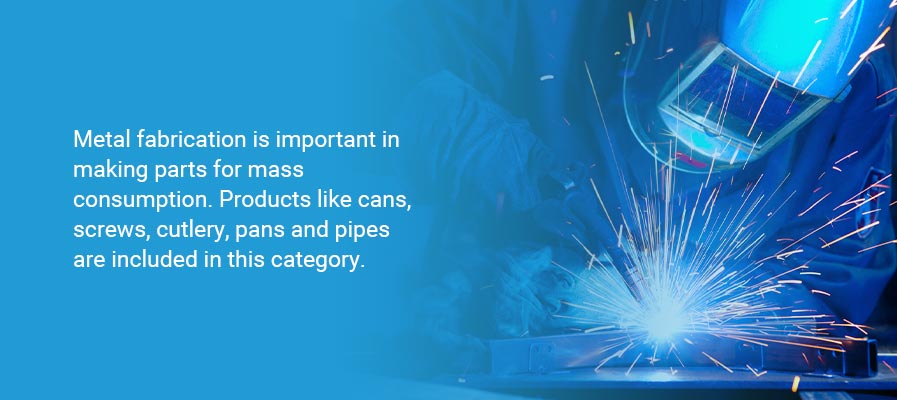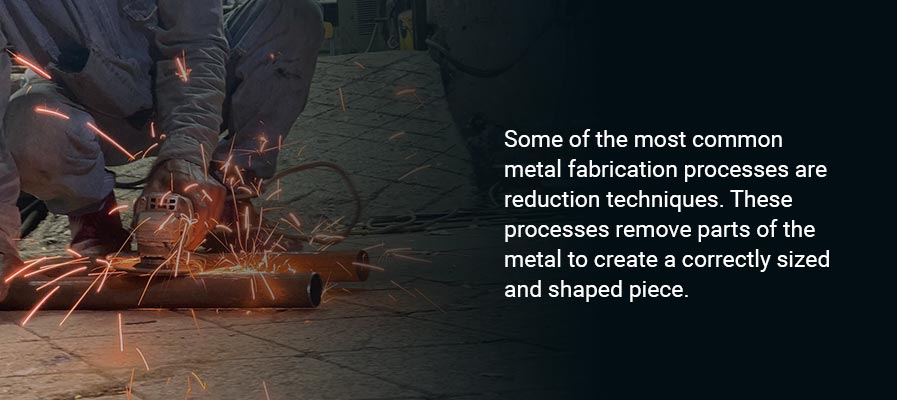 Metal fabrication is a manufacturing process used to shape metal into parts or end products. Most people think of welding when they hear metal fabrication, but welding is just one process metal fabricators use. We use several techniques to shape sheet metal into a part or good.
Metal fabrication is a manufacturing process used to shape metal into parts or end products. Most people think of welding when they hear metal fabrication, but welding is just one process metal fabricators use. We use several techniques to shape sheet metal into a part or good.
Though fabricated metal products are common and metal fabrication is a critical part of the manufacturing process, few people understand how the process works. From paper clips to plane parts, it’s used to create a wide variety of products for almost every industry. The United States saw nearly $353 billion USD of fabricated metal production in 2020 alone!
Most metal fabrication uses sheet metal, which can be up to 0.25 inches thick. Fabricators convert this sheet metal into products or tools that get stamped, folded, shaped or joined to create a finished component.
Some examples of products made from fabricated metal include:
Metal fabrication is important in making parts for mass consumption. Products like cans, screws, cutlery, pans and pipes are included in this category. These products tend to have consistent requirements and a wider tolerance for error. This means that the parts can differ in small ways from the original design and still function as expected.
Metal fabrication can also create large runs of customized fabricated metal products. These projects usually include the design and fabrication of customized metal parts to fit a business’s needs. Customized valves, car parts and hardware are all examples of this type of project.
 The Metal Fabrication Process
The Metal Fabrication ProcessAlthough most metal fabrication focuses on the shaping and cutting of metal, there are multiple steps involved in a successful fabricated project. The process starts with a design or rendering and ends with a finished, functional part.
The first step in any project is design. Some businesses come to us with a completed design. More commonly, businesses come to us with a prototype. We work with them to refine and test the design before starting a large run.
Today, many metal fabricators use Computer Aided Design (CAD) or Computer Aided Manufacturing (CAM) during the manufacturing process. With CAD and CAM programs, we’re able to develop a 3D prototype of an object before we actually begin to manufacture metal products.
Because a project can include many components, this phase helps ensure the product will function as required. From the prototype or rending, we’ll determine the size and shape of each part required and clarify the types of metal and finishing techniques needed.
The actual building process is the second step of a metal fabrication job. During this phase, we cut and shape each of the components from the design phase. The tools used to fabricate metal can include shears, mills, lathes and nibblers.
We often use CNC tools, or Computerized Numerical Controls, to ensure each piece is cut exactly to the specifications of the design. These tools extract a computer program of the exact commands and specifications used to create a piece. This program is then loaded into the CNC machine.
The finishing and assembling processes then strengthen the product and ensure it’s ready for use. Finishing techniques like grinding and deburring ensure the materials function properly and have no excess material. Metals might also be heat treated or plated with zinc or similar finishes for additional strength.
Fabricators also make sure products are marked and printed according to each project’s specifications. This can include measurements, company logos and other information.
Metal fabrication has applications in a wide variety of industries. Because of the versatility of tools and processes, it’s used to create parts for industries as varied as agriculture, spas, military craft and cars.
Some industry applications for metal fabrication include:
Fabrication is often associated with the automotive and heavy equipment industries. It’s used to make a variety of car parts, from engine components to caps and valves. We also manufacture components for planes. But metal fabrication doesn’t always mean small components. We also cut and join large pieces for tanks and transport vehicles and manufacture components for heavy-duty equipment.
Some industries have niche-specific requirements, like metal fabricated spa furniture or custom parts for lighting or machinery.
The metal fabrication process goes beyond simply shaping metal, and even the most straightforward products may require a variety of techniques and processing steps. Most metal fabrication falls into three primary categories:
Within these categories, a fabrication project might entail one or several of the following processes:
Every industry has different needs, and each fabricated piece has its own specifications. The metal fabrication process might include a variety of methods to reduce, shape and join materials.
Some of the most common metal fabrication processes are reduction techniques. These processes remove parts of the metal to create a correctly sized and shaped piece.
Examples include:
 Shaping Processes
Shaping ProcessesSometimes metal needs to be shaped instead of simply cut. There are varieties of different processes used to shape metal. During the fabrication process, metal is usually cut first, then shaped.
Shaping examples include:
Several other processes used during the metal fabrication process join different sheets of material together or shape large blocks of metal, such as:
Finding the right metal fabrication shop for your project can be challenging. Asking a few questions ahead of time can help you find the right fabricator. Here are five questions you should ask a metal fabrication shop before you decide:
When choosing a metal fabricator, one of the first questions to answer is whether the company has the capacity to take on your project. There’s a wide variety of metal fabricators in business. Some specialize in working with just one industry. Others offer a range of services.
If your fabrication project is complicated or has a very narrow tolerance for error, look for a company that specializes in precision fabrication. If a metal fabricator serves this field, they’re likely to have the skills and experience needed for other precision work.
Ask what the company’s standard project size is, as well. If a fabricator specializes in individualized products, it may not have the capacity to handle larger orders quickly.
It’s frustrating to hire a fabricator only to realize some of their services are outsourced. The unfortunate reality is that many fabricators do outsource steps of the design or finishing process.
Before selecting a metal fabricator, ask which services they offer and whether they outsource any of them. Does staff handle all of the building and fabricating steps? What is their experience in the field?
It can also be helpful to ask about support during the design process. Can you work with engineers at the company to modify your design if necessary?
Some customers come to us with a complete computer rendering and prototype. Others want to test and modify designs before manufacturing a large run. Our in-house engineering team can work with these customers to modify designs and offer suggestions on how to obtain the higher-quality part.
Experienced staff is critical for a successful metal fabrication project. Ask potential partners about the size of their staff and what experience they have in the field.
We recommend looking for businesses that have certified engineers and welders on staff. Certification provides proof that staff has the experience and skill necessary to complete your project successfully.
It’s common to get several bids when shopping for a metal fabricator, but not all bids provide the same information. When comparing bids from fabricators, make sure you understand exactly what’s included in the proposal.
Some of the things to look for in a bid include:
It can also be helpful to ask the business whether they’ve padded their bid and, if so, by how much. Most project proposals include some padding to account for any problems that might come up during the project, from modifying part of the design to sourcing materials.
Some of the best fabrication businesses, like Caldera Manufacturing Group, formerly Summit Steel, call the USA home. If you’ll be fabricating parts for use in the States, finding a fabricator based in the US can make a big difference. It will reduce shipping time and costs and cut down on problems with sourcing materials.
You may want to find out whether the fabricator has a warehouse or factory near your company, particularly if you’ll be fabricating large or heavy parts.
The location of suppliers and a company’s relationship with them are also important. If a shop has a good relationship with its suppliers and pays its bills on time, they’re more likely to be able to source materials easily. This is particularly important if your parts will require less common metals.
The metal fabrication industry will continue changing and growing as technology and increased market demand promise more streamlined fabrication processes. While much of this advancement will come from adopting more sophisticated technologies and better work processes, some of it also comes from increasing interest in applications like custom automotive fabrication.
Some trends to watch for include: